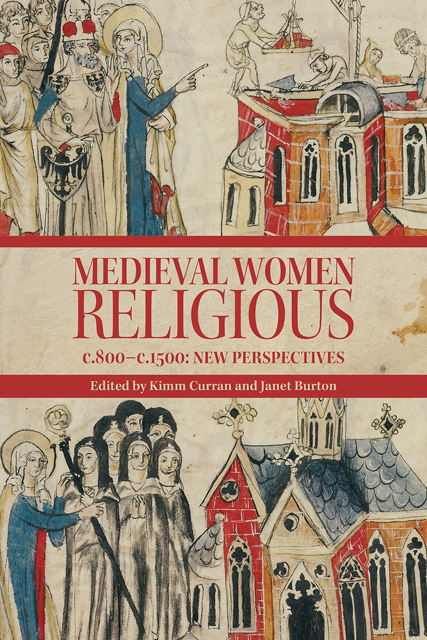Book contents
- Frontmatter
- Contents
- Illustrations
- Contributors
- Preface
- Abbreviations
- Introduction
- 1 Reform, Change, and Renewal: Women Religious in the Central Middle Ages, 800–1050
- 2 New Movements of the Twelfth Century: Diversity, Belonging, and Order(s)
- 3 Change and Renewal: Mendicants and Tertiaries in Later Medieval Europe
- 4 On the Fringes: Anchorites
- 5 ‘Quasi-religious’: Vowesses
- 6 Authority and Agency: Women as Heads of Religious Houses
- 7 Women Religious, Secular Households: The Outside World and Crossing Boundaries in the Later Middle Ages
- 8 Literacies, Learning, and Communal Reform: The Case of Alijt Bake
- 9 Family and Friends: Gift-giving, Books, and Book Inscriptions in Women’s Religious Communities
- 10 Communities of Medieval Religious Women and Their Landscapes
- 11 Materiality and Archaeology of Women Religious
- 12 Between Collective Memory and Individual Remembrance in Women’s Religious Communities
- Select Bibliography
- Index
- Miscellaneous Endmatter
6 - Authority and Agency: Women as Heads of Religious Houses
Published online by Cambridge University Press: 08 June 2023
- Frontmatter
- Contents
- Illustrations
- Contributors
- Preface
- Abbreviations
- Introduction
- 1 Reform, Change, and Renewal: Women Religious in the Central Middle Ages, 800–1050
- 2 New Movements of the Twelfth Century: Diversity, Belonging, and Order(s)
- 3 Change and Renewal: Mendicants and Tertiaries in Later Medieval Europe
- 4 On the Fringes: Anchorites
- 5 ‘Quasi-religious’: Vowesses
- 6 Authority and Agency: Women as Heads of Religious Houses
- 7 Women Religious, Secular Households: The Outside World and Crossing Boundaries in the Later Middle Ages
- 8 Literacies, Learning, and Communal Reform: The Case of Alijt Bake
- 9 Family and Friends: Gift-giving, Books, and Book Inscriptions in Women’s Religious Communities
- 10 Communities of Medieval Religious Women and Their Landscapes
- 11 Materiality and Archaeology of Women Religious
- 12 Between Collective Memory and Individual Remembrance in Women’s Religious Communities
- Select Bibliography
- Index
- Miscellaneous Endmatter
Summary
The image of medieval women religious that commonly springs to mind are those living in isolated circumstances, dedicating most of their time to prayer¬ful pursuits. But the tendency to analyse medieval women religious through the lens of enclosed and contemplative monasticism risks obscuring significant evidence of their authority and agency. In order to analyse how medieval religious women exercised power and what enabled them to do so, this chapter focuses on the office of the head of house, or superior, other convent officers, and the resulting collective influence of the diverse, women's monastic household. It draws primarily, but not exclusively, on evidence from Spanish, French, and English communities.
Women as Monastic Superiors and Other Convent Personnel
Within the convent the head of the community was the supreme authority in all things spiritual and temporal as they pertained to the maintenance of her commu¬nity. Although most religious rules (for example, Benedictine, Augustinian) were written with monasteries for men in mind, these were applied to women's reli¬gious communities with the understanding that the expectations for men applied equally to heads of women's communities. As the head of the foundation, all the other sisters owed the superior their obedience.
At the same time, the superior was one of the convent's own and, typically, it selected its monastic officers. Although dispensations could be granted, to be eligible for the office of head of house, a sister had to be of legitimate birth and twenty-one years or older (some religious orders specified a higher age). Before they could proceed with the internal election process, however, they had to seek permission from the crown (if a royal convent) or the convent's patron and/or the bishop to hold the election. Houses that were exempt from episcopal oversight typically designated another local ecclesiastic man to certify the installation of a new head. The Cistercian convent of Marham, for example, relied upon a local representative of the Cistercian General Chapter to oversee the selection of a new superior. Once the sisters received assent, they proceeded with an election. The Fourth Lateran Council of 1215 had regularised the procedures for choosing a new head of house, to bring them in line with how abbots and bishops were selected.
Perhaps because the position was freighted with such power and significance, the election of a new head of house could be a contentious affair.
- Type
- Chapter
- Information
- Medieval Women Religious, c.800-c.1500New Perspectives, pp. 105 - 120Publisher: Boydell & BrewerPrint publication year: 2023



